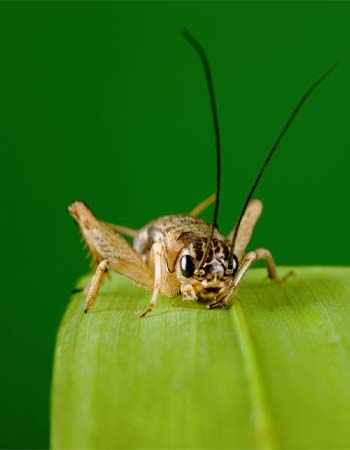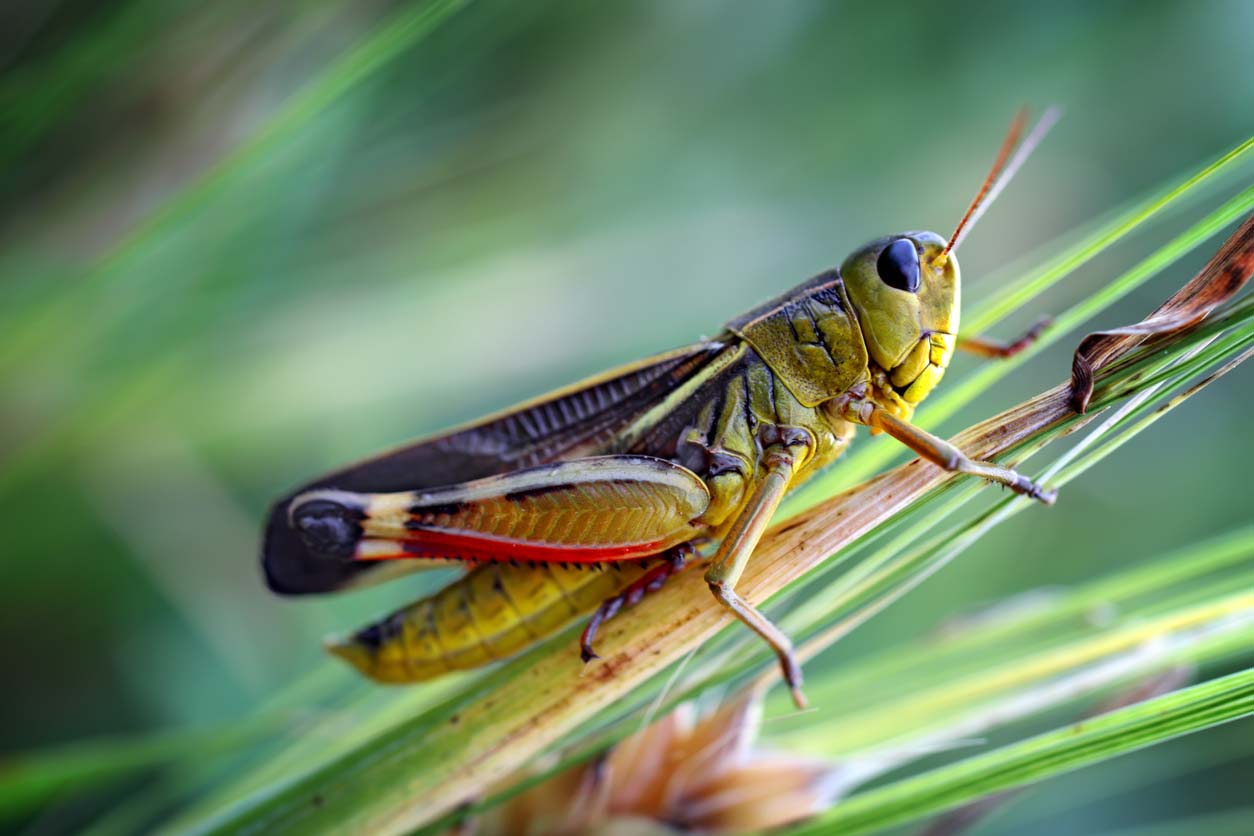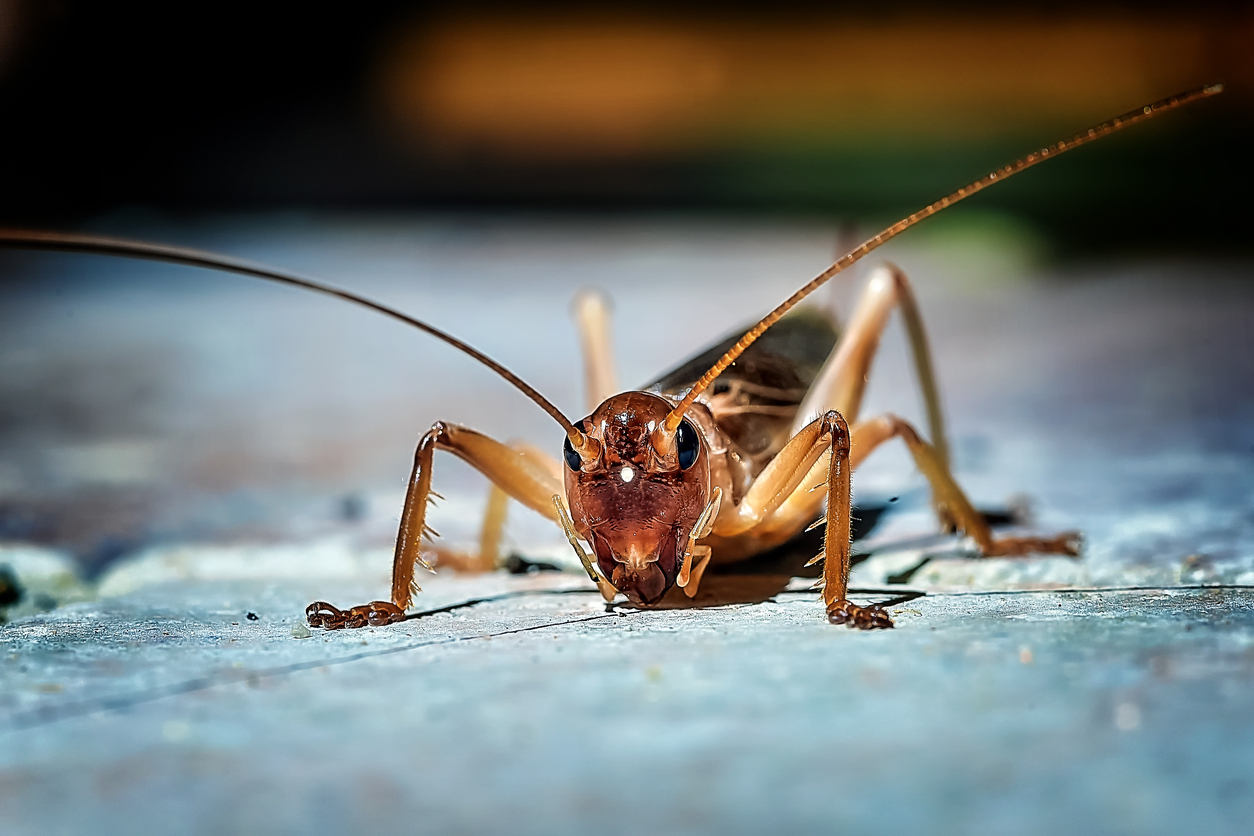

We may earn revenue from the products available on this page and participate in affiliate programs. Learn More ›
Crickets and grasshoppers are commonly confused with one another. While the two insects are both members of the Orthoptera order and share some similarities, there are actually a number of differences between crickets and grasshoppers that make it relatively easy to tell them apart.
If you have a pest living in your garage, basement, or garden and can’t tell if it’s a brown cricket or a brown grasshopper, continue reading. The sections below will delve into the key cricket vs. grasshopper differences to help you distinguish between these insects.
For the most part, grasshoppers have a larger body size than crickets, but crickets have longer antennae.

There are a few key differences in the appearance of crickets and grasshoppers. With their darker bodies, crickets are more likely to be mistaken for a cockroach than a grasshopper, the latter of which are more likely to have green or brown bodies.
Generally speaking, most grasshoppers have longer bodies than crickets. Depending on the species, grasshoppers can grow up to 4 or more inches in length. Most crickets, on the other hand, typically have a body length under 2 inches.
Despite their shorter bodies, crickets have longer antennae than most grasshoppers. In fact, a cricket’s antennae are often longer than their body, while the opposite is generally true for grasshoppers. Grasshoppers can be classified as short-horned or long-horned types. A long-horned grasshopper’s antennae will be longer than its wings, while short-horned grasshopper antennae are very short and stubby.
All types of grasshoppers have wings and most can fly, while only some crickets have wings. Field crickets and house crickets are two types of crickets with wings that are often found in and around suburban homes. Camel crickets and Jerusalem crickets, which are also often found in and around homes, do not have wings.
RELATED: Spotted Lanternfly Eggs Are Hatching Soon—Here’s What You Should Do
Both insects stridulate (or chirp), but in different ways and at different times.
Both crickets and grasshoppers are known for the signature chirping sounds they make. This singing or chirping is called stridulating. Although both crickets and grasshoppers stridulate, each insect actually has its own method of producing the chirps.
Grasshoppers rub their back legs against their wings to stridulate, while crickets rub their wings together to produce chirps. Both male and female grasshoppers can stridulate, though males do so more often than females. Only male crickets chirp; the females of the species are unable to do so.
The time of day when you’re most likely to hear chirping also differs between grasshoppers and crickets. Grasshoppers are diurnal, which means they are active during the day. They are more likely to stridulate when the sun is out. Meanwhile, most crickets are nocturnal, or active at night. Their chirping sounds are more likely to be heard after the sun goes down.

RELATED: 13 Fall Bugs That Are Invading Your Home—and What to Do About Them
Grasshoppers typically reproduce more and live longer than crickets.
The life cycles of crickets and grasshoppers are also different. When crickets mate in the spring and early summer, the females can lay up to 100 eggs. The eggs are laid in soil and hatch after about 2 weeks. When a newborn cricket hatches, it is in the nymph stage. A cricket nymph looks similar to an adult, but it isn’t fully formed until its exoskeleton molts 10 times. If young crickets can evade predators and other challenges, they typically live for about 2 months.
Grasshopper mating season is in the late summer. After mating, female grasshoppers deposit approximately 10 egg pods, each with up to 300 eggs. Grasshopper eggs incubate until the following spring. Young nymph grasshoppers look much like adult grasshoppers, but they do not have any wings yet.
Grasshopper nymphs molt up to 10 times during the first few weeks of their life, and each will be a fully-formed adult with wings by the end of the first month. A grasshopper can live up to 1 year.
Crickets are omnivores, whereas grasshoppers are herbivores.
Another main grasshopper vs. cricket difference relates to each insect’s diet. Crickets are omnivores, meaning they eat a mix of plants and animals. Some of the types of food a cricket may eat include larvae, aphids, grass, seeds, flowers, vegetables, or fruit. Crickets may even eat grasshoppers or their eggs.
Most grasshoppers are generally herbivores, which means they only eat plants. A grasshopper’s diet often consists of flowers, seeds, stems, and leaves. However, in some cases, grasshoppers may eat spiders, snails, worms, or other invertebrates. Lizards or snakes may even be eaten by grasshoppers on rare occasions. Contrary to “A Bug’s Life,” grasshoppers are quite self-sufficient and do not rely on (or steal from) ants for food.

Both insects can be destructive in a home garden, but crickets are more inclined to move indoors.
Both crickets and grasshoppers can cause a lot of damage to gardens, crops and natural resources. In particularly bad years with large grasshopper infestations, it is possible for the insects to destroy 20 percent or more of an area’s crops. While they prefer alfalfa, wheat, corn, and soybeans, they can also cause damage to other crops, trees, or residential gardens when there is a very large grasshopper population.
Crickets are much more likely to enter houses than grasshoppers. They can chew holes in clothing, furniture, flooring, and baseboards. While crickets are not typically aggressive toward humans, they may bite out of self-defense, but their jaws aren’t normally strong enough to break the skin.
While some say that having crickets inside can bring good fortune to your home, most want to know how to get rid of the insects to prevent damage or an infestation.
Once you clear up crickets in your home, you can take steps to prevent them from entering. Sealing cracks in the foundation and ensuring there are no gaps around your doors can help. You should also work to keep weeds and long grass away from your home’s exterior and make sure firewood isn’t left right up against the house.
